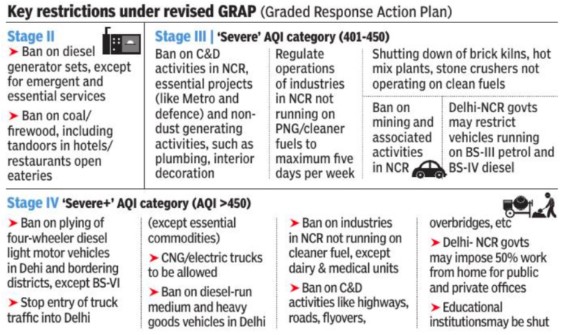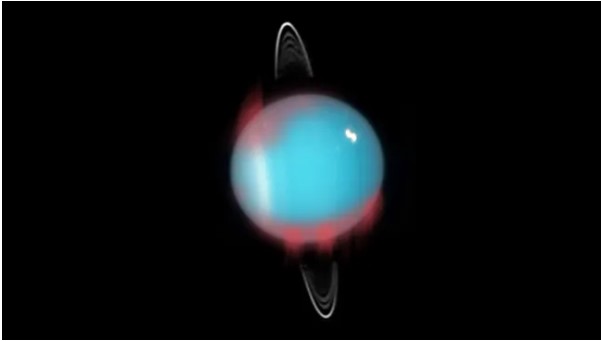Graded Response Action Plan (GRAP)
With the National Capital Region’s (NCR) Air Quality Index (AQI) deteriorating to the ‘severe’ category, the Commission for Air Quality Management invoked measures under Stage 4 of the Graded Response Action Plan (GRAP) with immediate effect.
Commission for Air Quality Management (CAQM) is a statutory body responsible for formulating strategies to combat pollution in the region.
- GRAP is a set of emergency measures to be taken to reduce air pollution.
- Formation - The Supreme Court mandated Environment Pollution (Prevention and Control) Authority (EPCA) formulated and notified the plan in 2017 after SC approval in 2016.
- Activation of GRAP – GRAP does not include yearlong measures and only incremental actions which gets activated on the basis of values of AQI.
|
GRAP stages
|
Activation Criteria
|
|
Stage 1
|
When the AQI is in ‘poor’ category (201 to 300)
|
|
Stage 2
|
When AQI is in ‘Very poor’ category (301-400)
|
|
Stage 3
|
when the AQI is in ‘Severe’ category (401-450)
|
|
Stage 4
|
When AQI rises to the ‘Severe +’ category (>450)
|
- Imposition of measures – Before imposing measures, EPCA holds a meeting with representatives from all NCR states.

The BS-VI fuel was estimated to bring around an 80% reduction of sulphur, from 50 parts per million to 10 ppm.
- Coordination - GRAP creates a step-by-step plan for the entire Delhi-NCR region and getting on board 13 different agencies of NCR regions (Delhi, Uttar Pradesh, Haryana and Rajasthan).
3 major policy decisions of EPCA and GRAP are the closure of the thermal power plant at Badarpur, bringing BS-VI fuel to Delhi before the deadline set initially, and the ban on Pet coke as a fuel in Delhi NCR.
Reference
The Indian Express | GRAP IV implemented in Delhi-NCR Region
Indo-Pacific Partnership for Maritime Domain Awareness (IPMDA)
On the sidelines of the 4th Goa Maritime Conclave (GMC) in 2023, the Indian Navy Chief stressed that Indo-Pacific Maritime Domain Awareness (IPMDA) is a testament to India’s commitment to a free, open, inclusive and rules-based Indo-Pacific.
- IPMDA - It offers a near-real-time, integrated, and cost-effective maritime domain awareness picture which is fundamental for stability and prosperity in the Indian Ocean Region (IOR).
- Formation - It was announced by the Quad grouping, comprising India, Australia, Japan and U.S., at the Tokyo summit in early 2022.
- Activities - It involves sharing best practices, conducting joint exercises, and fostering a sense of collective responsibility.
- This will integrate three critical regions of the Indo-Pacific Region.
- The Pacific Islands
- Southeast Asia, and
- The Indian Ocean region
- Benefits
- Combat illegal fishing
- Allows tracking of dark shipping
- Helps in responding to humanitarian and natural disasters
- Secure maritime interests, including energy and trade routes, as well as supply chain vulnerabilities.
- Ensures the safety of critical Sea Lines of Communication (SLOC)
- Better management of marine resources and environmental protection.
Dark Shipping is a vessel operating with its Automatic Identification System (AIS) turned off and thereby operates unmonitored.
- Challenges - Infrastructure constraints and continued delay in posting Indian liaison officers at others facilities and centres in the region.
Indian Navy’s Information Fusion Centre for Indian Ocean Region (IFC-IOR) located at Gurugram, had greatly improved the situational awareness in the region and thus would play a pivotal role in the IPMDA.
Reference
The Hindu | Importance of IPMDA
Agri Tourism
The 1st agri-tourism facility of Andhra Pradesh has been setup at Chintapalli in Alluri Sitharama Raju (ASR) district.
- Agri-tourism is a niche and an emerging market segment of the tourism industry.
The father of agri-tourism in India is Pandurang Taware who pioneered this concept in Maharashtra in 2005.
- Need - Climate change, tourism led pollution and increasing urbanisation have resulted in rising demand for natural and rural destinations as tourist attractions.
- Features - It is a non-urban hospitality product, serving an agrarian lifestyle, culture and heritage.
- Objectives
- To generate income
- To promote environmental awareness
- To strengthen community ties
- To enhance cultural awareness
The agri-tourism market globally was valued at $42.46 billion in 2019 and is expected to reach $62.98 billion by 2027 and in India, agri-tourism revenue is growing at an annual growth rate of 20% in 2019.
- Rural development - It provides employment opportunities and increases the market for traditional rural products.
- Tribal development - It will help the tribal people to conserve their traditional practices and will help in checking their migrations.
- Agriculture development - It restore farmers’ confidence in agriculture and ecosystem-based services by supporting incomes of farmers.
- Sustainable Development - It create tourism forms for tourists contributing to economic, social, and environmental dimensions of sustainability.
National Tourism Day is celebrated on January 25 and World Tourism Day is celebrated on September 27.
References
- The Hindu | 1st Agri Tourism in Andhra Pradesh
- The Hindu Business Line | Agri Tourism
Uranus Aurora
The Keck II Near-Infrared Spectrometer (NIRSPEC) telescope in Mauna Kea, Hawaii is the 1st to see the infrared glow on Uranus, caused by hydrogen molecules in its atmosphere becoming excited.

- Aurora formations - Charged particles from the solar wind engage with magnetic field of Uranus, steering them towards its magnetic poles.
- When these particles enter Uranus atmosphere, they collide with its atmosphere molecules, setting them glow.
- Aurora colour - It is predominantly at ultraviolet and infrared wavelengths as dominant atmospheric gases in Uranus are hydrogen and helium at much lower temperatures than on Earth.
On Earth, the auroral light comes from collisions with oxygen and nitrogen atoms, with the colours mostly red, green and blue.
- The ultraviolet aurora on Uranus was first seen in 1986 by NASA's Voyager 2 probe, which flew past the planet.
- The Uranus molecular hydrogen gets ionized and forms H3+ cations following collisions with charged particles, with the emission creating an infrared auroral glow over the northern magnetic pole.
Reference
Times of India | Uranus Aurora
Giraffe
Giraffes could go extinct soon as there are now fewer than 70,000 mature individuals left in the wild.
- Scientific Name - Giraffa camelopardalis
- Habitat – They use both semi-arid savannah and savannah woodlands in Africa.
- They can live as long as 25 years and eat a very wide variety of trees and shrubs.
Giraffes are the world’s tallest mammals and an African icon.
- Status – IUCN Red List currently recognises 1 species of giraffe and 9 subspecies which is vulnerable as a whole while some are Critically Endangered.
- Threat – They have declined by 40% in the last 30 years and there are 5 biggest threats in recent times.
- Habitat loss – Habitat loss outside protected areas is the main reason for the recent decline.
Traditional pastoralists like the Maasai in northern Tanzania maintain large spaces of natural savannah.
- Insufficient law enforcement – There is high illegal hunting (poaching) for bush meat markets.
- Ecological changes – Development activities disrupt the natural movement patterns, affects their food availability and mobility.
- Climate change – Though unaffected by the higher temperatures, increased seasonal rainfall is associated with lower giraffe survival due to disease and lower food quality.
- Lack of knowledge and awareness – They are often overlooked and underrepresented in wildlife research, funding and policy.
Reference
Down To Earth| Giraffe under Threat

